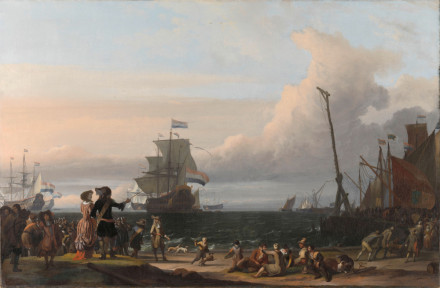History
The Vrouwe Maria Jakoba made a total of three return voyages to Asia. After arrival in Batavia in April 1774, the ship remained there. This often happened with ships who were deemed unfit for the arduous voyage back to the Netherlands. A few years later, in 1780, the ship was 'laid off' near the island Onrust (Kapal Island) near the roads of Batavia. This means that the ship was partly deconstructed/demolished and that the remains stayed in place. The ship's bell has been preserved and is kept in the National Maritime Museum in Amsterdam.

Spotted typhus epidemic
On 18 November 1711, the Vrouwe Maria Jakoba left from the island of Texel for her second voyage to Batavia. She already returned the following day. This was repeated two more times. It turned out that an epidemic of spotted typhus (then called spotted fever) had broken out on board and that a large part of the crew was ill. The sickness spread around the ship like wildfire and the captain was forced to turn around. The disease had quickly spread across the whole Christmas fleet of the VOC (the ships Huys te Meyen, Honkoop, Kronenburg, Groenendaal and the Maria Jakoba).

Upon the return to Texel, captain de Mooy wanted to take all the sick off the ship and put them in quarantine in the emergency hospital in the Schans (a fortress near Oudeschild) on Texel. The Schans however was already filled with the sick of the other ships. Because of this, de Mooy decided to take the sick to the home port of Hoorn in small ships (lichters). But when they came there, the city council refused to let them come ashore. The ships were sent back and ended up near the Nieuwediep waterway off the city of Den Helder. There, they were put up in a place called the tonnenboet, a shed used to store buoys. The shed was in a bad shape and the elements had free play. So this was an unfit place for sick people, who needed to be kept in quarantine.
Good advice was costly and after a lot of discussion and many deaths, the sick were taken by boats to the full Schans in Texel again. They remained in quarantine there until the epidemic had passed. In total, 46 of them died in the Schans. It was a very contagious disease. Doctors who had been in contact with the diseased, also died. Women who washed the clothes of the patients and who took care of them, also died. In total, 760 people died.
Aftermath
Because of this incident, the Heren XVII (the board of the VOC) took a number of measures. Crew members were checked by a surgeon before being allowed to board. Furthermore, in 1776, a hospital ship was stationed in the Nieuwediep near Den Helder.
The Vrouwe Maria Jakoba dit leave for Asia on 27 January 1772. During the voyage, 25 crew members died.
Description
Tonnage: 880 ton/440 last
| Skipper | Maarten Pietersz. Mooy |
|---|---|
| People on board | 112 |
| Length | 140 feet (42.7 m) |
Status
Because the ship was demolished, there probably is no wreck present on the site.

References
- DAS 7873.2.
- Roeper, V., Vonk-Uitgeest, I. (2002).
Texel en de VOC.
Maritiem en Jutters museum. - Woesik, H (2000).
Scheepsbel van 'De Vrouwe Maria Jacoba'.
Oud Hoorn.